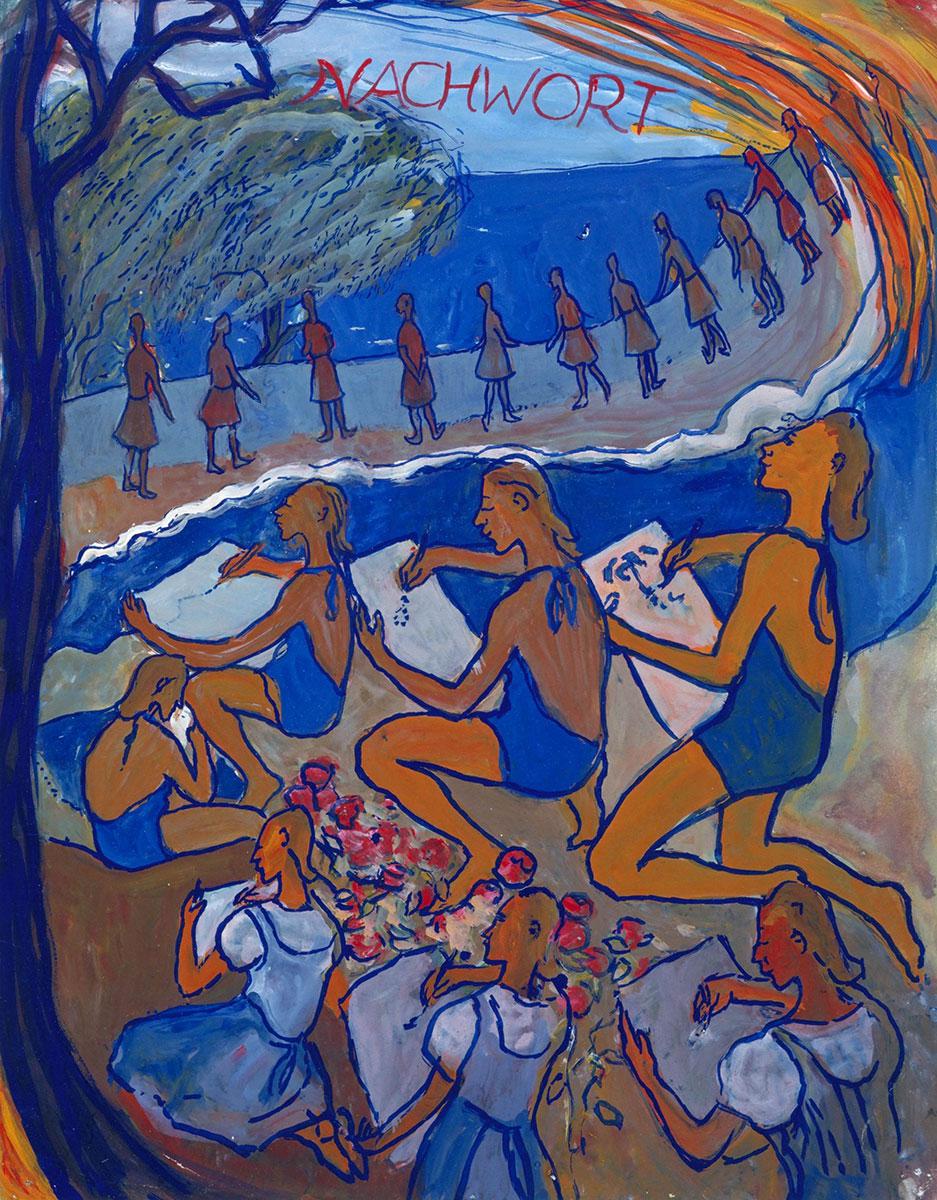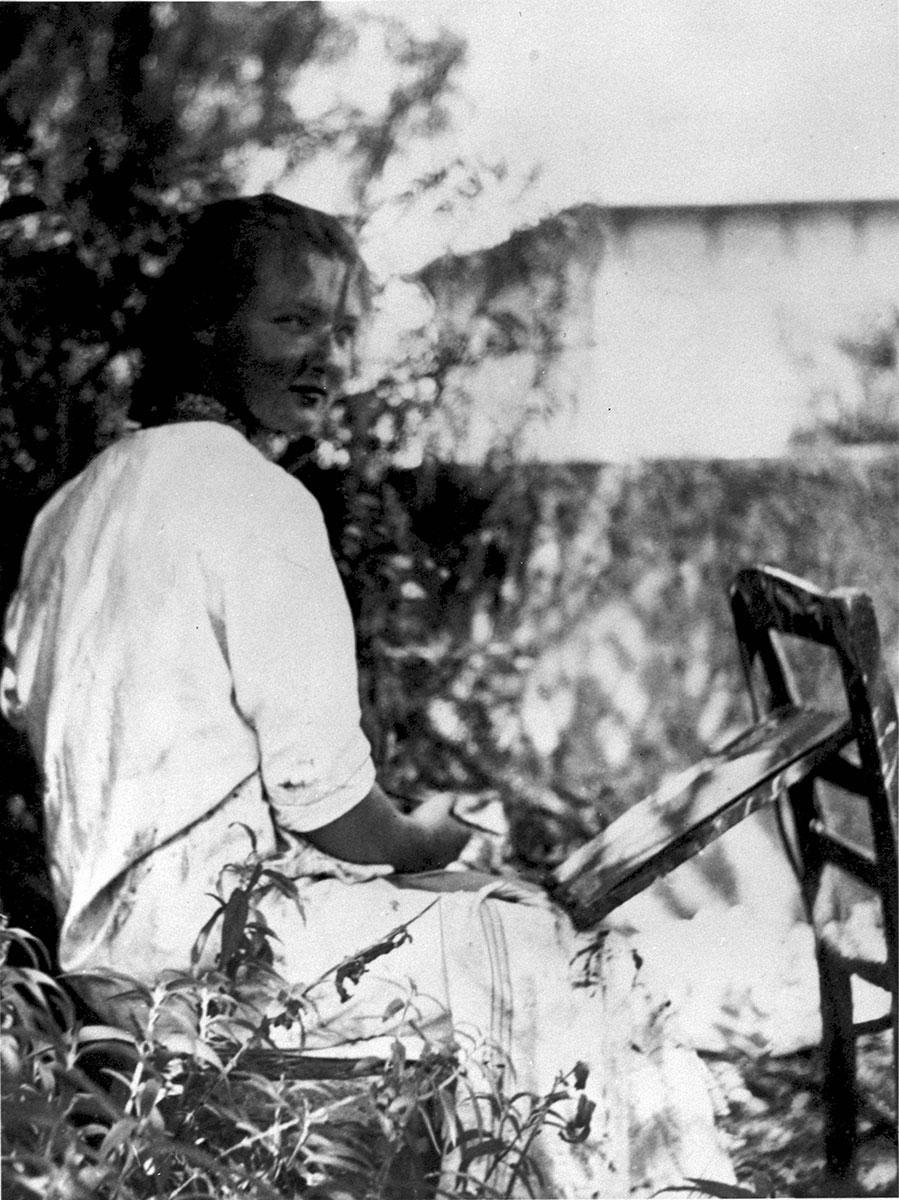
Gouache on paper



Sunday to Thursday: 09:00-17:00
Fridays and Holiday eves: 09:00-14:00
Yad Vashem is closed on Saturdays and all Jewish Holidays.
Entrance to the Holocaust History Museum is not permitted for children under the age of 10. Babies in strollers or carriers will not be permitted to enter.

Gouache on paper



“And with dream-awakened eyes she saw all the beauty around her; saw the sea, felt the sun, and knew: she had to vanish for a while from the human plane and make every sacrifice in order to create her world anew out of the depths.”
(From “Life? Or Theatre?”, Charlotte Salomon, 1940-1942)
The year 1940 caught Charlotte Salomon on the French Riviera, in the throes of a deep depression. Forced to leave her parents behind, she had fled her German homeland the year before and joined her beloved grandparents in France. But the Nazis had invaded France, and her grandmother committed suicide. Now, 23 years old and desolate, Charlotte felt that her life, too, had come to an end.
As a possible antidote to Charlotte’s crippling depression, her doctor recommended she resume painting. And when Charlotte received a shipment of art supplies, the despairing young woman began using them to liberate her tormented soul.
Charlotte’s art turned into an existential voyage of self-discovery, an odyssey in which she could explore life, death and art—and the links between them. Over the course of two years she produced 1,300 works of art, her prolific creativity fueled by an uncontrollable urge, and the fear that the clock was ticking.
She named her works “Life? Or Theater?” and her question marks call for the viewer’s response. Are we witnessing reality or illusion? Where is the boundary between art, life and death? The answers are found in the body of her works, which are nothing less than a personal encounter between each of these components. Helpless, we are pulled into a marathon that leaves us breathless and drained—almost like the artist herself.
For young Charlotte, a protagonist in the theater of life, a final curtain awaited. Deported from France and sent to Auschwitz-Birkenau, she was murdered upon arrival; along with the child she carried in her womb. When these two lives were cut short, the question marks lost their significance, for in Auschwitz there was neither life nor theater. There was only the cowardly murder of an artist who had succeeded through the power of her soul to delve into the depths and retrieve hues of such colossal vitality that they continue to awe onlookers 60 years after her murder.
“I will create my story so that I will not lose my mind,” wrote Charlotte in her last letter to her parents. And, indeed, by the sheer strength of her creativity, she was able to escape the suicidal fate that haunted her family. Yet even such resolve couldn’t withstand the physical power of Nazi troops.
Art cannot replace life, but it has the power to endure. In this display of her works at Yad Vashem, Charlotte Salomon finally becomes the victor in the cruel theater of life
Charlotte Salomon 1917-1943
Charlotte Salomon was born in Berlin in 1917. Her family was immersed in Berlin’s cultural and social life. Despite being Jewish, she was admitted in 1935 to the city’s School of Fine Arts and Applied Crafts. Charlotte’s father was arrested during Kristallnacht and, in the wake of the pogrom, her family decided that Charlotte should unite with her grandparents, who had found refuge in Villefranche, France. There, under Nazi occupation, she created a series of hundreds of paintings, entitled “Life? Or Theater?”—an autobiographical narrative recounting the fate of her family and that of German Jewry. In the summer of 1943, Charlotte married Alexander Nagler, a Jewish refugee, and in September the couple was arrested. They were deported to Auschwitz, where Charlotte, pregnant with their first child, and Alexander were murdered.
The Exhibition “Life? Or Theater?” was organized by the Jewish Historical Museum, Amsterdam, and sponsored by Le Comité français pour Yad Vashem, Stichting Vrienden van Yad Vashem - Nederland and Jacqueline and Michael Gee, U.K. It was on display between 16 June and 1 October 2006, in Yad Vashem’s Exhibitions Pavilion.
First published in Yad Vashem Jerusalem magazine, #42, July 2006

Thank you for registering to receive information from Yad Vashem.
You will receive periodic updates regarding recent events, publications and new initiatives.

"The work of Yad Vashem is critical and necessary to remind the world of the consequences of hate"
Paul Daly
#GivingTuesday
Donate to Educate Against Hate


Worldwide antisemitism is on the rise.
At Yad Vashem, we strive to make the world a better place by combating antisemitism through teacher training, international lectures and workshops and online courses.
We need you to partner with us in this vital mission to #EducateAgainstHate
The good news:
The Yad Vashem website had recently undergone a major upgrade!
The less good news:
The page you are looking for has apparently been moved.
We are therefore redirecting you to what we hope will be a useful landing page.
For any questions/clarifications/problems, please contact: webmaster@yadvashem.org.il
Press the X button to continue



